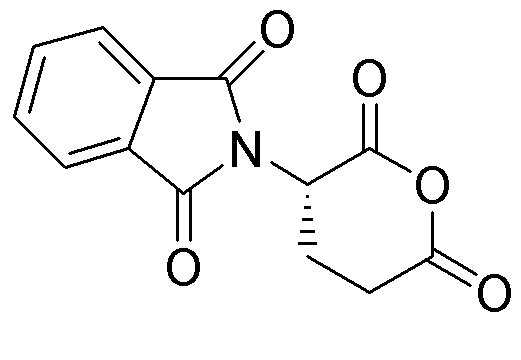Phthaloyl-L-glutamic acid anhydride is widely utilized in research focused on:
- Peptide Synthesis: This compound serves as a key reagent in the synthesis of peptides, enhancing the efficiency of coupling reactions and improving yields in pharmaceutical development.
- Drug Delivery Systems: It is employed in the formulation of drug delivery systems, particularly in creating biodegradable polymers that can release therapeutic agents in a controlled manner, benefiting the pharmaceutical industry.
- Bioconjugation: The compound is used for bioconjugation processes, allowing researchers to attach biomolecules to surfaces or other molecules, which is critical in developing diagnostic tools and targeted therapies.
- Research in Biochemistry: It plays a significant role in biochemistry research, particularly in studying enzyme mechanisms and protein interactions, providing insights that can lead to new therapeutic strategies.
- Polymer Chemistry: Phthaloyl-L-glutamic acid anhydride is utilized in polymer chemistry for the synthesis of novel materials with specific properties, which can be tailored for applications in various industries, including packaging and electronics.
General Information
Properties
Safety and Regulations
Applications
Phthaloyl-L-glutamic acid anhydride is widely utilized in research focused on:
- Peptide Synthesis: This compound serves as a key reagent in the synthesis of peptides, enhancing the efficiency of coupling reactions and improving yields in pharmaceutical development.
- Drug Delivery Systems: It is employed in the formulation of drug delivery systems, particularly in creating biodegradable polymers that can release therapeutic agents in a controlled manner, benefiting the pharmaceutical industry.
- Bioconjugation: The compound is used for bioconjugation processes, allowing researchers to attach biomolecules to surfaces or other molecules, which is critical in developing diagnostic tools and targeted therapies.
- Research in Biochemistry: It plays a significant role in biochemistry research, particularly in studying enzyme mechanisms and protein interactions, providing insights that can lead to new therapeutic strategies.
- Polymer Chemistry: Phthaloyl-L-glutamic acid anhydride is utilized in polymer chemistry for the synthesis of novel materials with specific properties, which can be tailored for applications in various industries, including packaging and electronics.
Documents
Safety Data Sheets (SDS)
The SDS provides comprehensive safety information on handling, storage, and disposal of the product.
Product Specification (PS)
The PS provides a comprehensive breakdown of the product’s properties, including chemical composition, physical state, purity, and storage requirements. It also details acceptable quality ranges and the product's intended applications.
Certificates of Analysis (COA)
Search for Certificates of Analysis (COA) by entering the products Lot Number. Lot and Batch Numbers can be found on a product’s label following the words ‘Lot’ or ‘Batch’.
Numéro de catalogue
Numéro de lot/série
Certificates Of Origin (COO)
This COO confirms the country where the product was manufactured, and also details the materials and components used in it and whether it is derived from natural, synthetic, or other specific sources. This certificate may be required for customs, trade, and regulatory compliance.
Numéro de catalogue
Numéro de lot/série
Safety Data Sheets (SDS)
The SDS provides comprehensive safety information on handling, storage, and disposal of the product.
DownloadProduct Specification (PS)
The PS provides a comprehensive breakdown of the product’s properties, including chemical composition, physical state, purity, and storage requirements. It also details acceptable quality ranges and the product's intended applications.
DownloadCertificates of Analysis (COA)
Search for Certificates of Analysis (COA) by entering the products Lot Number. Lot and Batch Numbers can be found on a product’s label following the words ‘Lot’ or ‘Batch’.
Numéro de catalogue
Numéro de lot/série
Certificates Of Origin (COO)
This COO confirms the country where the product was manufactured, and also details the materials and components used in it and whether it is derived from natural, synthetic, or other specific sources. This certificate may be required for customs, trade, and regulatory compliance.


